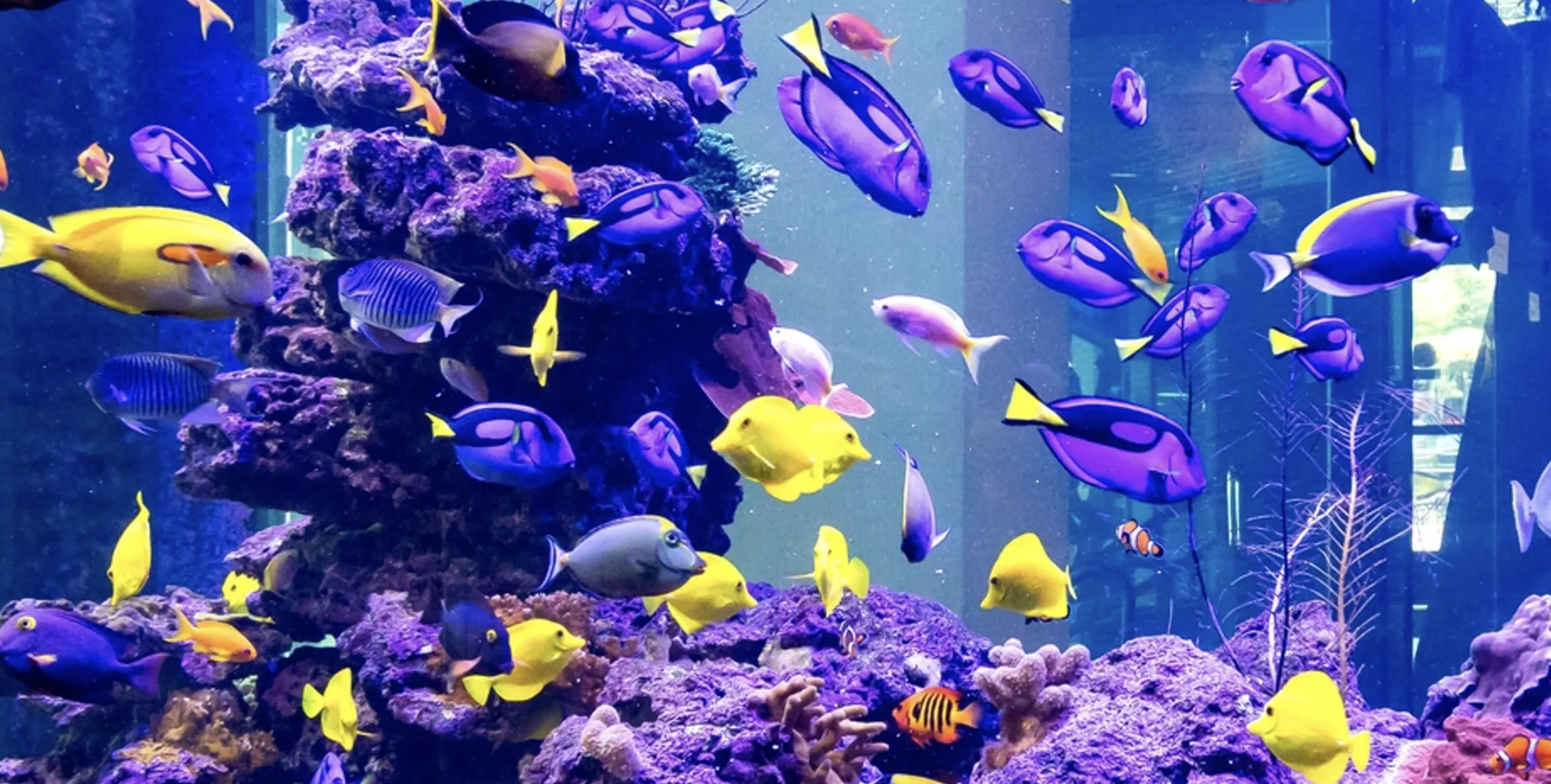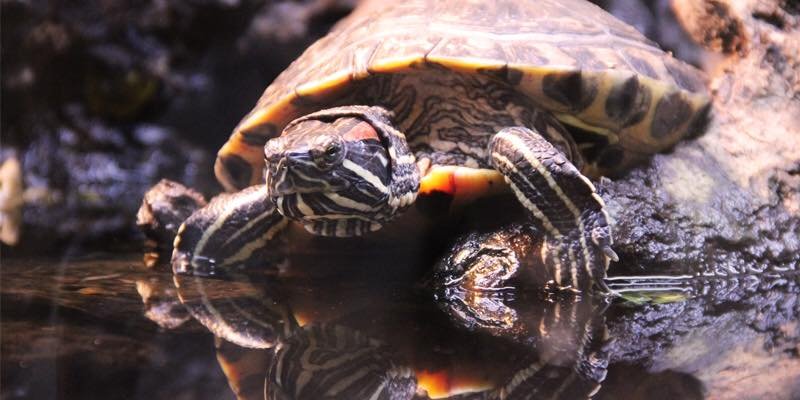center in the square aquariums
Living Coral Reef Aquarium
Our spectacular 8,000 gallon living coral reef aquarium is the largest aquarium of its type in the Mid-Atlantic Region. It is home to 250 colorful marine fish and 150 live soft and stony corals. The living coral reef system will grow and change over time and offers exceptional SOL compliant educational value, as well as providing enjoyment for all those who visit and observe. Exciting new technologies with interactive screens provide a learning experience for everyone.
The mention of coral reefs brings to mind warm climates, colorful fish and clear waters. However, the reef itself is actually a component of a larger ecosystem. The coral community is a system that includes a collection of biological communities, representing one of the most diverse ecosystems in the
world. They're like cities under the sea filled with colorful fish, intricate formations and wondrous sea creatures.
The importance of coral reefs, however, extends far beyond the pleasure it brings to those who explore it. Coral reefs play an essential role in everything from water filtration and fish reproduction to shore line protection and erosion prevention. Coral reefs are one of the most biologically diverse
ecosystems on earth, rivaled only by tropical rain forests.
Sea creatures that call this aquarium home include Gorgonians, Marine Sponges, Sea Cucumbers, Snails, Hermit Crabs, Sea Biscuits, Sea Stars and more. We are proud and grateful to have a wonderful donor who has sponsored the large aquarium.
special tank exhibit: Predators of the amazon
The Amazon River is the widest river in the world and at any point in time has the highest volume of water flowing down it. During dry season the river can be 6 miles wide and during the wet season it can be 25 miles wide! The Amazon River Basin triples throughout the year between the dry and wet seasons.
The Amazon River flows into the Atlantic Ocean and is responsible for 20% of the freshwater input throughout all oceans worldwide. This magnificent river is very important to South America as it drains nearly 40% of this region and is the lifeline to one of the world’s largest ecosystems, the Amazon Rainforest.
The basin and rainforest are incredibly important to the local and global climate. The Amazon Rainforest acts as a carbon dioxide sink, taking in nearly two billion tons of carbon dioxide each year. The rainforest also absorbs heat which helps with the creation of tropical storms. Tropical storms are important in redistributing heat around the globe. The Amazon Rainforest is a major force that drives atmospheric circulation, which is why it is important to help protect the Amazon Rainforest and Amazon River.
In addition to supporting the biodiversity of the Amazon Rainforest, the Amazon River also supports diverse wildlife. River dolphins, anacondas, piranha and thousands of other fish species call the Amazon River home.
The Amazon River also has economic significance. While the Rainforest supplies wood and other natural resources, the Amazon River allows commercial fisheries to generate income. Some large ornate predatory fish have become popular in aquarium trade. Fishermen will go out in hand carved canoes or dugouts. Their fishing provides income which takes pressure off the South American cities, and the timbering of the Amazon Rainforest. In addition to exporting fish for educational and personal aquariums, many tourists have taken an interest in the Amazon River as well and travel to the Amazon River for fishing.
Turtles of Virginia Fresh Water Aquarium
The Turtles of Virginia aquarium features several species that live in the lakes, creeks and rivers of Western Virginia. It has become an instant favorite.
Current residents of the aquarium include a Map Turtle, two Painted Turtles and a Red Eared Slider. The turtles take turns swimming and resting on a 300 lb piece of driftwood collected from the side of the river. They are already eating from the hands of Center’s Aquarium curators!
The Map Turtle gets its name from the markings on its underside, which resembles those on a map or chart. The Map turtle is found from the southern United States to Canada, mostly on larger lakes and rivers.
The Painted Turtles are named for the beautiful red and green markings on their undersides. Adults reach 5-7 inches, meaning the turtles at Center in the Square are nearly full grown. They can be found in local rivers, creeks, lakes and ponds.
Red-Eared Sliders get their name from the small red dash around their ears. The “slider” part of their name comes from their ability to slide off rocks and logs and into the water quickly. This turtle is among the most popular pet turtles in the world, and has become a part of the native wildlife after pets either escaped or were released by their owners.
Chomp Tank
The most notable species in this exhibit is the Lionfish. These fish have fins that are loaded with venom and they are considered an invasive species. along the East Coast and the Caribbean. This exhibit is also home to a beautiful French Angelfish, Humu Triggerfish, and a colorful Spanish Hogfish. There are also two Pufferfish that greet everyone who comes to view the aquarium! This very active tank is a crowd pleaser at Center in the Square.
koi pond (6th floor)
Koi are the most recognized fish in the world. They are graceful, vibrant and respected.
They are usually associated with Japan, but they actually originated from Central Asia in China.
They got their name around 500 B.C., but the fish itself has been around for millions of years according to fossil records. The colors and patterns that adorn Koi today were made through natural genetic mutation.
According to legend, a huge school of Koi swam upstream the Yellow River located in China. The fish acquired more strength by battling with the current. When the school reached a waterfall at the end, many
of the fish went back and let the current of the river carry them away. The Koi that stayed did not give up.
They leaped from the depths of the river and tried to reach the very top of the waterfall to no avail. Local demons noticed their efforts and mocked them by increasing the height of the waterfall. After a hundred years of jumping one Koi finally reached the top of the waterfall. The gods noticed
its determination and turned it into a golden dragon,
the image of power and strength.
“feed the fish” and support our aquariums!
Click the link below to donate today.






